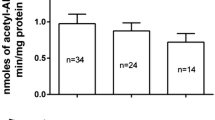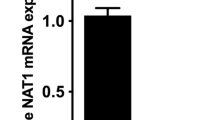Abstract
N-Acetylation is a phase II conjugation reaction mediated in humans by the polymorphic N-acetyltransferase 2 (NAT2) and N-acetyltransferase 1 (NAT1). Acetylation of some drugs may be modestly decreased in patients with chronic liver disease, whereas acute liver injury has no effect on drug acetylation. For NAT2 substrates, the impairment in acetylation capacity seems to be phenotype-specific, with a more prominent effect being exerted in rapid than slow acetylators. Thus, in the presence of significant hepatic dysfunction, the activity of NAT2 may not exhibit its usual bimodal distribution, and hence phenotypic assignment may not be reliable. Furthermore, it remains to be evaluated whether the precautions advised for slow acetylators when treated with drugs metabolised by NAT2 apply to all patients (regardless of phenotype) with liver cirrhosis.
Similar content being viewed by others
References
Weber WW, Hein DW. N-acetylation pharmacogenetics. Pharmacol Rev. 1985; 37: 25–79.
Cribb AE, Nakamura H, Grant DM, et al. Role of polymorphic and monomorphic human arylamine N-acetyltransferases in determining sulfamethoxazole metabolism. Biochem Pharmacol. 1993; 45: 1277–82.
Vatsis KP, Weber WW, Bell DA, et al. Nomenclature for N-acetyltransferase. Pharmacogenetics. 1995; 5: 1–17.
Grant DM, Houghes NC, Janezic SA, et al. Human acetyl-transferase polymorphisms. Mutat Res 1997; 376; 61–70.
Perry Jr HM, Tan EM, Carmody S, et al. Relationship of acetyl transferase activity to antinuclear antibodies and toxic symptoms in hypertensive patients treated with hydralazine. J Lab Clin Med. 1970; 76: 114–25.
Lunde PKM, Frislid K, Haustein V. Disease and acetylation polymorphism. Clin Pharmacokinet. 1977; 2: 182–97.
Woosley RL, Drayer DE, Reidenberg MM, et al. Effect of acetylator phenotype on the rate at which procainamide induces antinuclear antibodies and the lupus syndrome. N Engl J Med. 1978; 298: 1157–9.
O’Neil WM, Gilfix BM, DiGirolamo A, et al. N-Acetylation among HIV-positive patients and patients with AIDS: when is fast, fast and slow, slow? Clin Pharmacol Ther. 1997; 62: 261–71.
Shear NA, Spielberg SP, Grant DM, et al. Differences in metabolism of sulfonamides predisposing to idiosyncratic toxicity. Ann Intern Med. 1986; 105: 179–89.
Buhl R, Jaffe HA, Holroyd KY, et al. Systemic glutathione deficiency in symptom-free HIV-sero-positive individuals. Lancet. 1989; II: 1294–8.
Ellard GA, Gammon PT. Acetylator phenotyping of tuberculosis patients using matrix isoniazid or sulfadimidine and its prognostic significance for treatment with several intermittent isoniazid-containing regimens. Br J Clin Pharmacol. 1977; 4: 5–14.
Ratain MI, Mick R, Berezin F, et al. Paradoxical relationship between acetylator phenotype and amonafide toxicity. Clin Pharmacol Ther. 1991; 50: 573–9.
Hein DW. Acetylator genotype and arylamine-induced carcinogenesis. Acta Biochem Biophys. 1988; 948: 37–66.
Roots I, Drakoulis N, Brockmoller J. Polymorphic enzymes and cancer risk. Concepts, methodology and data review. In: Kalow W, editor. Pharmacogenetics of drug metabolism. New York: Pergmon Press, 1992: 815–41.
Yu MC, Skipper PL, Taghizadeh K, et al. Acetylator phenotype, aminobiphenyl-hemoglobin adduct levels, and bladder cancer risk in White, Black and Asian men in Los Angeles, California. J Natl Can Inst. 1994; 86: 712–6.
Feng Y, Rustan TD, Ferguson RJ, et al. Acetylator genotypedependent formation of 2-aminofluorene-hemoglobin adducts in rapid and slow acetylator Syrian hamsters congenic at the NAT2 locus. Toxicol Appl Pharmacol. 1994; 124: 10–5.
Vineis P, Bartsch H, Caporaso N, et al. Genetically based N-acetyltransferase metabolic polymorphism and low-level environmental exposure to carcinogens. Nature. 1994; 369: 154–6.
Hein DW, Doll MA, Rustan TD, et al. Metabolic activation of N-hydroxyarylamines and N-hydroxyarylamides by 16 recombinant human NAT2 alloenzymes: effect of 7 specific NAT2 nucleic acid substitutions. Cancer Res. 1995; 55: 3531–6.
McLean AJ, Morgan DJ. Clinical pharmacokinetics in patients with liver disease. Clin Pharmacokinet. 1991; 21: 42–69.
Hoyumpa A, Schenker S. Is glucuronidation truly preserved in patients with liver disease. Hepatology. 1991; 13: 786–95.
Desmond PV, Smyth FE, Mashford ML. Release of latent glucuronosyltransferase activity contributes to the sparing of glucuronidation in experimental liver injuries. J Gastroenterol Hepatol. 1994; 9: 350–4.
Held H, Fried F. Elimination of para-aminosalicylic acid in patients with liver disease and renal insufficiency. Chemotherapy. 1977; 23: 405–15.
Souich P, Erill S. Metabolism of procainamide and p-aminobenzoic acid in patients with chronic liver disease. Clin Pharmacol Ther. 1977; 22: 588–95.
Pacifici GM, Viani A, Franchi M, et al. Conjugation pathways in liver disease. Br J Clin Pharmacol. 1990; 30: 427–35.
Dowling TC, Frye RF, Matzke GR, et al. Reduced acetylation of PAH in liver disease [abstract]. Clin Pharmacol Ther. 1997; 61: 215.
Horvath T, Par A, Past T, et al. Disorders of biotransformation during the progression of alcoholic liver disease. Acta Physiol Hung. 1986; 4: 351–7.
Horvath T, Past T, Nemeth A, et al. Drug metabolism in drug induced liver diseases: pathogenetic role of active metabolites. Acta Physiol Hung. 1989; 73: 293–304.
Ahmad R, Al-Taee M. The effect of acute viral hepatitis on the activity of N-acetyltransferase. IntHepatol Commun. 1995; 3: 123–5.
Horvath T, Past T, Tatai Z, et al. Investigation of biotransformation capacity in patients with chronic liver diseases by pharmacokinetic methods: experimental trials. Pol J Pharmacol Pharm. 1984; 36: 361–71.
Timbrell JA, Wright JM. Urinary metabolic profile of isoniazid in patients who develop isoniazid-related liver damage. Human Toxicol. 1984; 3: 485–95.
Levi AT, Sherlock S, Walker D. Phenylbutazone and isoniazid metabolism in patients with liver disease in relation to previous drug therapy. Lancet. 1968; I: 1275–9.
Accocella G, Bonollo L, Garimoldi M, et al. Kinetics of rifampin and isoniazid administrated alone and in combination to normal subjects and patients with liver disease. Gut. 1972; 13: 47–53.
Filho RAP, Seva-Pereira A, de Magalhaes AFN, et al. A acetilacao da isoniazida na cirrose hepatica. Rev Paul Med. 1985; 103: 276–9.
Levy M, Leibowitz Y, Zylber-Katz E, et al. Impairment of dipyrone’s metabolism in asymptomatic carriers of hepatitis B virus. Clin Pharmacol Ther. 1997; 62: 6–14.
Zylber-Katz E, Caraco Y, Granit L, et al. Dipyrone metabolism in liver disease. Clin Pharmacol Ther. 1995; 58: 198–209.
May DG, Arns PA, Richards WO, et al. The disposition of dapsone in cirrhosis. Clin Pharmacol Ther. 1992; 51: 689–700.
Rodopoulos N, Wisen O, Norman A. Caffeine metabolism in patients with chronic liver disease. Scand J Lab Invest. 1995; 55: 229–42.
Denaro CP, Wilson M, Jacob P, et al. The effect of liver disease on urine caffeine metabolic ratios. Clin Pharmacol Ther. 1996; 59: 624–35.
El-Yazigi A, Raines DA, Abdel Wahab F, et al. Relationship between antipyrine metabolism and acetylation phenotype in health and chronic liver diseases. J Clin Pharmacol. 1995; 35: 615–21.
Irshaid YM, Al-Hadid HF, Abuirjeie MA, et al. N-acetylation phenotyping using dapsone in a Jordanian population. Br J Clin Pharmacol. 1991; 32: 289–93.
Horai Y, Ishizaki T. N-acetylation polymorphism of dapsone in Japanese population. Br J Clin Pharmacol. 1988; 25: 487–94.
Tang BK, Kadar D, Qian L, et al. Caffeine as a metabolic probe: validation of its use for acetylator phenotyping. Clin Pharmacol Ther. 1991; 49: 648–57.
Author information
Authors and Affiliations
Rights and permissions
About this article
Cite this article
Levy, M., Caraco, Y. & Geisslinger, G. Drug Acetylation in Liver Disease. Clin Pharmacokinet 34, 219–226 (1998). https://doi.org/10.2165/00003088-199834030-00004
Published:
Issue Date:
DOI: https://doi.org/10.2165/00003088-199834030-00004




